Discover the Best Communication Tools for Remote Teams in 2025
In a modern distributed work environment, selecting the right communication tools is critical for productivity, safety, and legal compliance. For New Zealand businesses, especially those in demanding sectors like construction, agriculture, maritime, and emergency response, the challenge extends far beyond simple video calls. It requires a robust mix of digital platforms and rugged, reliable hardware that functions flawlessly from the Auckland CBD to the most remote corners of the South Island.
This guide moves past generic reviews to provide an in-depth analysis of the best communication tools for remote teams in NZ for 2025. We explore everything from sophisticated team messaging apps to legally compliant two-way radios and essential satellite phones, focusing on solutions readily available and supported in New Zealand. To power up your distributed team, exploring the best collaboration tools for distributed teams is essential, but our focus here is on the foundational communication layer.
You will find a comprehensive breakdown of each solution, complete with feature analysis, pricing details, and practical implementation advice tailored to Kiwi industries. We will examine which tools meet legal communication standards and address the unique operational needs of local sectors, ensuring your team stays connected, compliant, and safe, no matter where the job takes them. Each entry includes direct links and screenshots to help you make a fully informed decision. Our goal is to equip you with a curated list of platforms that solve real-world communication problems, helping you find the perfect fit for your team's specific requirements, whether they're in an office, on-site, or at sea.
1. Slack
As a cornerstone of digital collaboration, Slack has established itself as one of the best communication tools for remote teams, particularly for office-based staff coordinating with field personnel. It excels at organising asynchronous and real-time conversations into dedicated channels for specific projects, teams, or topics. This structure is invaluable for a construction firm managing multiple sites, allowing separate channels for site-specific updates, health and safety bulletins, and equipment logistics, keeping everyone informed without information overload.
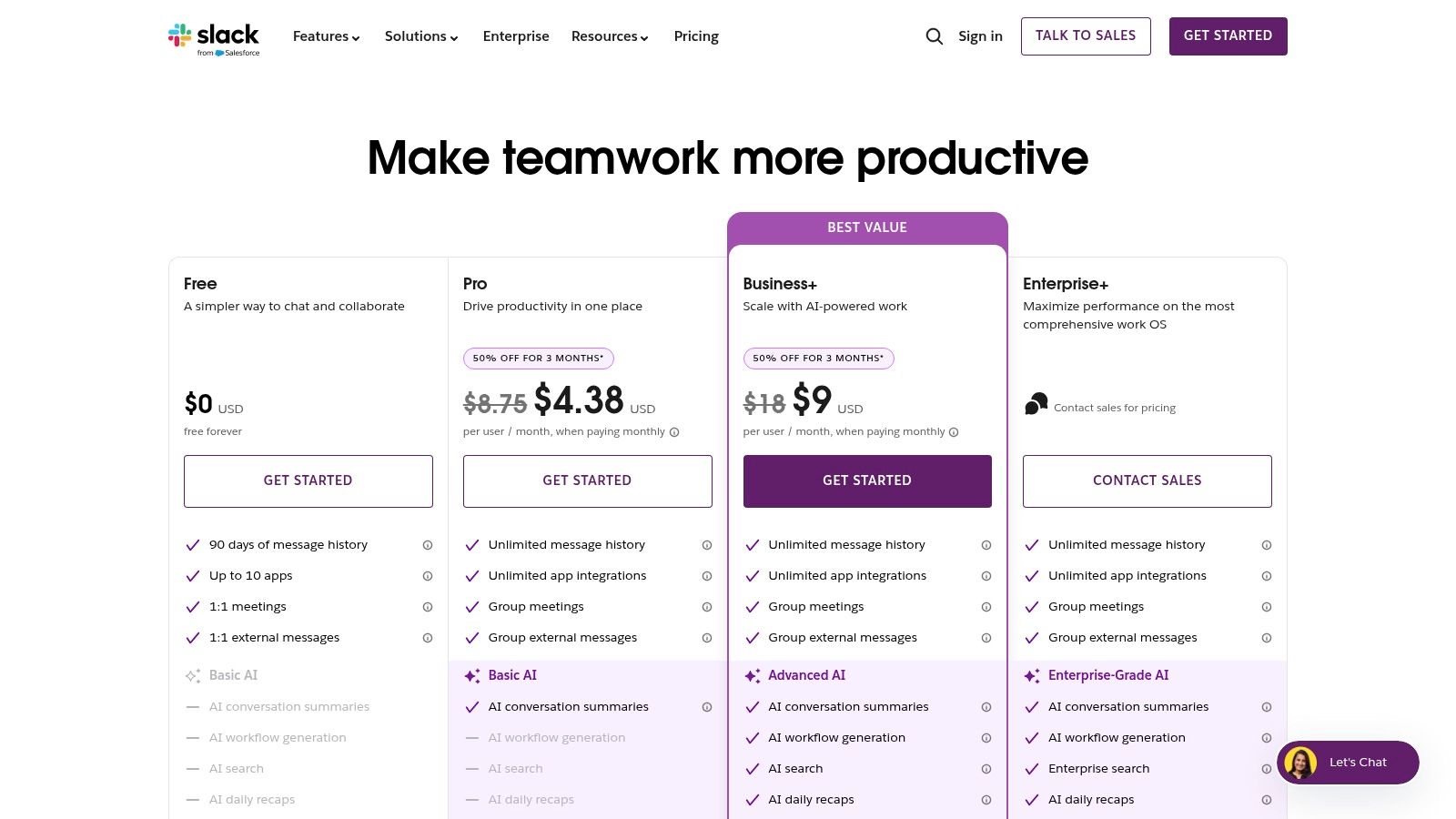
Its powerful search function lets users quickly find past conversations, files, or decisions, which is crucial for accountability and project continuity. Features like Huddles allow for instant audio or video calls, perfect for a quick, impromptu problem-solving session that would otherwise require a formal meeting. To fully leverage Slack for remote team productivity, consider learning how to make a Slack bot that boosts productivity for automating routine check-ins or updates.
Key Considerations
- Best For: Teams needing a central digital hub for daily communication, file sharing, and integrating other software tools. It's ideal for project managers, administrative staff, and leadership in industries like construction, logistics, and tourism.
- Limitations: The free plan's 90-day message history limit is a significant drawback for long-term record-keeping. The reliance on internet connectivity makes it unsuitable as a primary tool for remote field workers in areas with poor coverage. For a deeper look at how digital platforms like Slack fit into the broader communications landscape, you can explore the evolution of the world of communication.
- Pricing: Paid plans (Pro, Business+) unlock unlimited history, more integrations, and advanced security, starting from NZD$12.75 per active user/month when billed annually. See current Slack pricing.
2. Microsoft Teams
For organisations already embedded within the Microsoft 365 ecosystem, Microsoft Teams emerges as a powerful and logical choice among the best communication tools for remote teams. It seamlessly integrates chat, video meetings, file storage, and application integration into a single, cohesive platform. This is particularly beneficial for a logistics company coordinating operations across multiple depots, where a project manager can co-author a Word document, discuss changes in a persistent chat, and launch a video call with drivers and warehouse staff, all without leaving the Teams interface.
The platform's strength lies in its deep integration with tools like SharePoint and OneDrive, providing a robust back-end for document management and version control, crucial for maintaining accurate records in construction or engineering projects. Generous meeting capacities, allowing up to 300 participants for up to 30 hours even on its small business plans, make it suitable for large-scale training sessions or company-wide announcements.
Key Considerations
- Best For: Businesses heavily invested in the Microsoft 365 suite looking for a unified collaboration platform. It excels in environments like professional services, large-scale construction project management, and corporate offices where document collaboration is paramount.
- Limitations: The user interface can feel more complex and less intuitive than some competitors. Its value is maximised within the Microsoft ecosystem, offering fewer benefits for teams using diverse, non-Microsoft software. Recent regulatory changes in some regions have also introduced complexity to its plan structures.
- Pricing: Often bundled with Microsoft 365 Business plans, which reduces direct costs. Standalone plans and add-ons like Teams Phone and Teams Rooms are available. For detailed options, see the official Microsoft Teams business pricing.
3. Zoom Workplace
Initially known for its world-class video conferencing, Zoom has evolved into a comprehensive platform called Zoom Workplace, making it one of the best communication tools for remote teams. Its strength lies in its low-friction user experience, particularly for external meetings. Inviting a client, contractor, or stakeholder to a call is seamless, as they can join directly from a browser without needing to download software or create an account. This is invaluable for industries like construction or logistics when coordinating with external partners who may not use the same internal software.
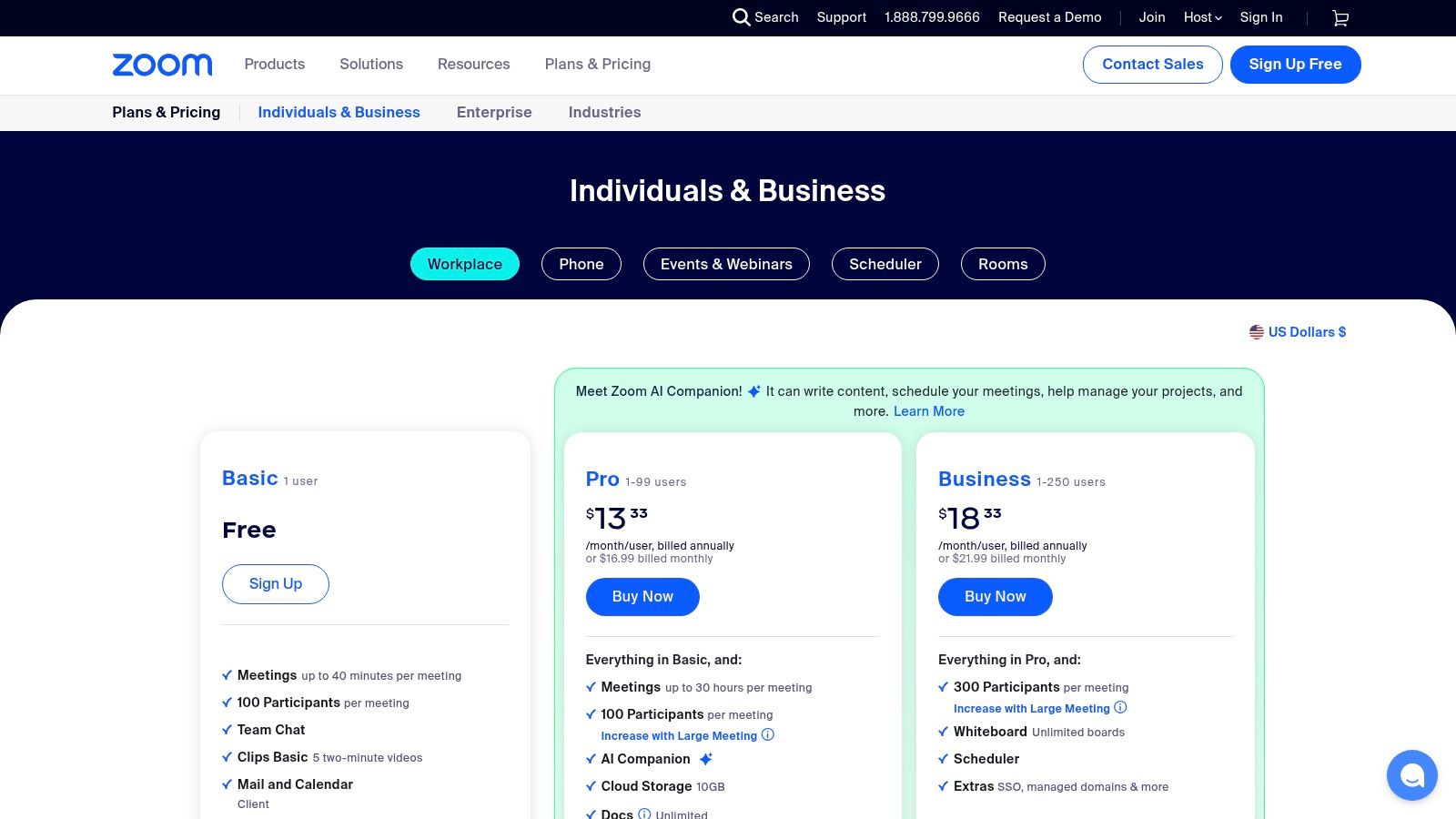
The platform now bundles Team Chat, an interactive Whiteboard, and video Clips into its core offering, competing directly with all-in-one hubs. Paid plans include the powerful AI Companion, which can summarise meetings and suggest chat replies, boosting productivity for busy project managers. The platform's real value for New Zealand businesses lies in its reliability and broad hardware support, ensuring clear communication whether in a head office or a temporary site office.
Key Considerations
- Best For: Teams that heavily rely on external video communication with clients, suppliers, or subcontractors. It's ideal for sales, client services, and high-level project coordination across various sectors.
- Limitations: While the base AI features are included in paid plans, advanced customisation requires an additional paid add-on. The cost can also escalate significantly when adding optional bundles like Zoom Phone for VoIP calling or Zoom Rooms for dedicated conference room hardware.
- Pricing: A free Basic plan is available. Paid plans (Pro, Business) add features like longer meetings, cloud recording, and the AI Companion, with pricing available on their website. See current Zoom pricing.
4. Google Workspace
For organisations deeply embedded in Google's ecosystem, Google Workspace stands out as one of the best communication tools for remote teams by offering a seamless, all-in-one suite. It integrates essential tools like Gmail, Meet, Chat, and Drive, providing a cohesive environment that simplifies workflows for office-based staff coordinating with mobile teams in sectors like logistics or tourism. The platform excels at real-time collaboration, allowing multiple users to co-edit documents, spreadsheets, and presentations simultaneously, which is invaluable for joint tender preparations or project planning.
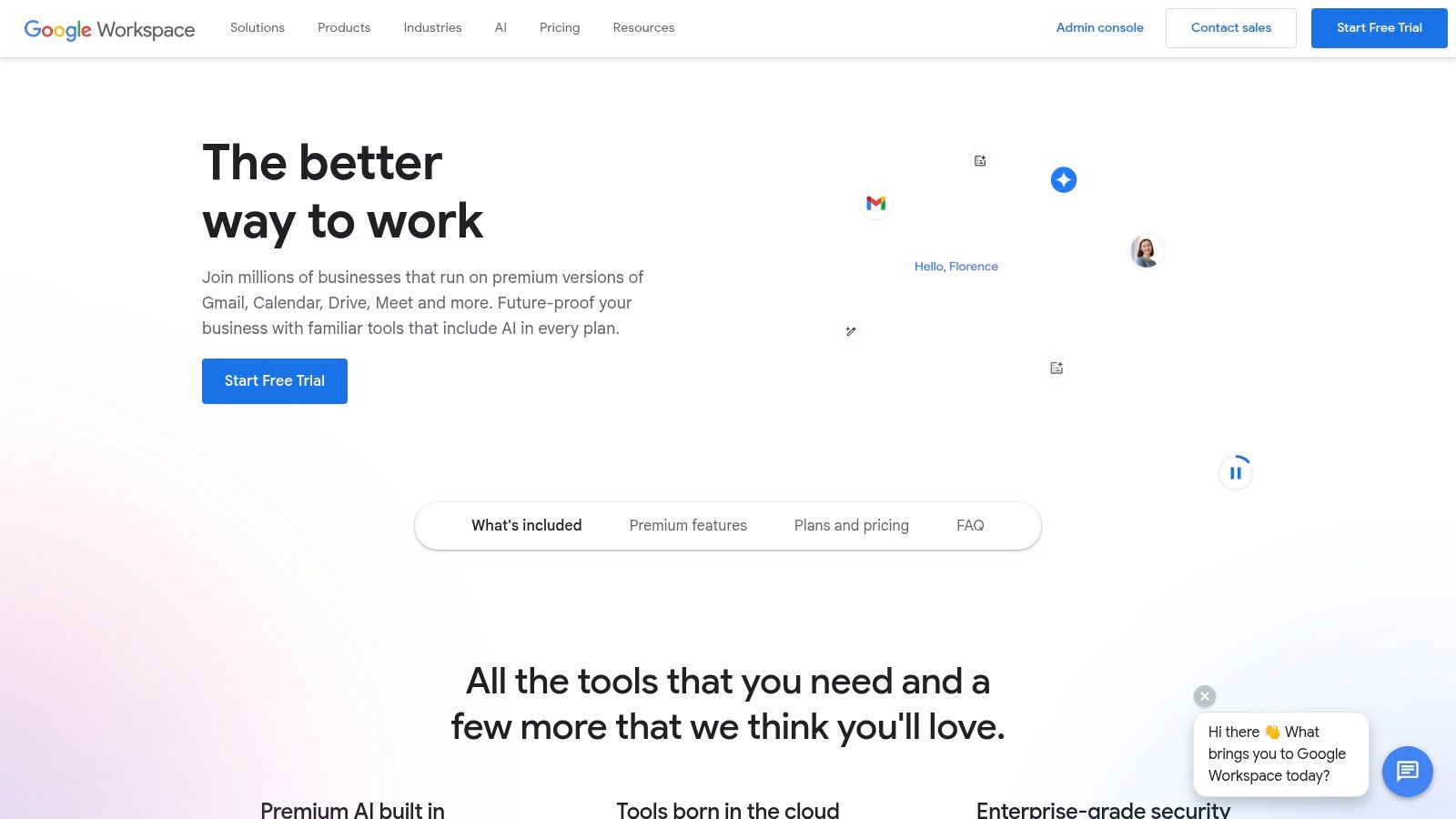
Its strength lies in its simplicity and unified user experience, making onboarding new staff straightforward. Google Meet supports video conferences with 100 to 500 participants, while the new Gemini AI integration (available on Standard and higher plans) assists with drafting emails and summarising meeting notes. This centralised approach ensures all communications, files, and collaborative efforts are housed under one secure, admin-controlled roof, enhancing productivity and information security.
Key Considerations
- Best For: Businesses of all sizes that already use or prefer Google's services, needing a cost-effective, integrated solution for email, video conferencing, file storage, and real-time document collaboration.
- Limitations: The Business Starter and Standard plans have a 300-user limit, making them unsuitable for larger enterprises. Some organisations may find its file compatibility less seamless with external partners who primarily use Microsoft Office formats.
- Pricing: Offers transparent NZD pricing with a 14-day free trial. Paid plans like Business Starter and Business Standard offer increased pooled storage and features, with pricing available directly on their site. See current Google Workspace pricing.
5. Cisco Webex Suite
Cisco Webex Suite positions itself as a robust, enterprise-grade platform among the best communication tools for remote teams, particularly those in regulated industries like finance, healthcare, or government contracting. Its strength lies in combining secure meetings, messaging, and advanced calling features into a single, unified solution. For a large logistics company with operations across New Zealand and internationally, this means having one vendor for everything from daily team chats to formal, large-scale webinars and integrated PSTN calling for their main office lines.

The platform is distinguished by its powerful AI capabilities, such as real-time noise removal and automatic transcriptions, which are invaluable for maintaining clarity during meetings with participants in noisy environments like a busy packhouse or a construction site office. The integration of Slido for interactive polls and Q&As directly within meetings enhances engagement, making it ideal for training sessions or company-wide briefings. Its mature and reliable infrastructure provides peace of mind for mission-critical communications.
Key Considerations
- Best For: Organisations requiring a highly secure, all-in-one communication stack with strong compliance certifications (e.g., FedRAMP). It suits businesses that need reliable video conferencing, enterprise calling, and team messaging managed under one secure umbrella.
- Limitations: The free plan’s 40-minute meeting limit can be restrictive for teams needing longer collaborative sessions. Pricing complexity can also be a hurdle, as costs often vary depending on the specific reseller and regional agreements in New Zealand.
- Pricing: A free plan is available. Paid plans (Meet, Suite, and Enterprise) offer expanded features like longer meetings, cloud recording, and advanced calling. Custom pricing is typical for enterprise deployments. See current Webex pricing.
6. RingCentral (RingEX)
RingCentral (RingEX) moves beyond simple team chat to offer a complete unified communications system, making it one of the best communication tools for remote teams needing to replace a traditional office phone system. It consolidates phone, video, and team messaging into a single platform, providing a seamless experience for businesses managing both office-based administration and dispersed field personnel. For a logistics company, this means a single business number can route calls to a driver’s mobile app, a warehouse manager’s desk phone, or an administrator’s computer, ensuring no critical call is missed.

Its strength lies in its robust cloud-based PBX features, including advanced call routing, auto-attendant, and extensive integration capabilities with over 330 applications. This allows a construction firm to integrate its communication system directly with its CRM or project management software, streamlining workflows and centralising client interactions. The platform's reliability is a key advantage, especially when paired with strong cellular signal boosters to ensure connectivity in more remote areas; you can explore solutions like a Cel-Fi cellular repeater to maximise uptime for VoIP-based tools.
Key Considerations
- Best For: Businesses requiring a comprehensive, cloud-based phone system with integrated team messaging and video conferencing. It is ideal for organisations with client-facing roles, such as sales teams in manufacturing or administrative staff in tourism, who need a professional communication front.
- Limitations: The pricing structure can be complex, with many key features locked behind higher-tier plans. The sheer number of features may be overwhelming for smaller teams who only need basic communication tools, potentially leading to paying for unused capabilities.
- Pricing: Plans start from the 'Core' tier at NZD$33 per user/month, scaling up to 'Ultra' for more advanced features like unlimited storage and device analytics. Annual and volume discounts are available. See current RingCentral pricing.
7. Loom
Loom revolutionises asynchronous communication by replacing lengthy emails and unnecessary meetings with quick, shareable video messages. It has become one of the best communication tools for remote teams, especially those working across different time zones or needing to provide detailed visual feedback. For a design team in an architectural firm, Loom allows a project lead to record their screen, walk through CAD drawings, and provide specific, contextual feedback, which is far more effective than written notes. This approach clarifies instructions and drastically reduces misunderstandings.

The platform is exceptionally user-friendly, enabling one-click screen and camera recording directly from a browser or desktop app. Once recorded, a shareable link is instantly generated, which can be embedded in other tools like Slack or Jira. Its AI features, available in the Business plan, can automatically generate titles, summaries, and action items from a video, saving valuable administrative time. This is perfect for creating training materials, documenting processes, or sending detailed project updates without coordinating schedules.
Key Considerations
- Best For: Teams that need to provide visual explanations, tutorials, or feedback asynchronously. It's ideal for training, design reviews, and software walkthroughs in sectors like technology, marketing, and professional services.
- Limitations: While excellent for one-way communication, it isn't a replacement for real-time collaborative brainstorming or urgent problem-solving. As Atlassian integrates Loom into its product suite, some enterprise features may require existing Atlassian accounts, which could be a hurdle during the transition period.
- Pricing: A free plan is available for individuals. Paid plans (Business) start at US$12.50 per user/month, unlocking unlimited videos, AI features, and enhanced security. See current Loom pricing.
8. Miro
When communication needs to be visual rather than just verbal, Miro provides an infinite digital whiteboard that is essential for remote teams. It shines in scenarios requiring collaborative brainstorming, strategic planning, or complex process mapping, making it one of the best communication tools for remote teams focused on design and development. For instance, a logistics company can use Miro to visually map out a new supply chain route, allowing team members from different departments to add inputs, identify bottlenecks, and refine the process in real-time, just as if they were in the same room.
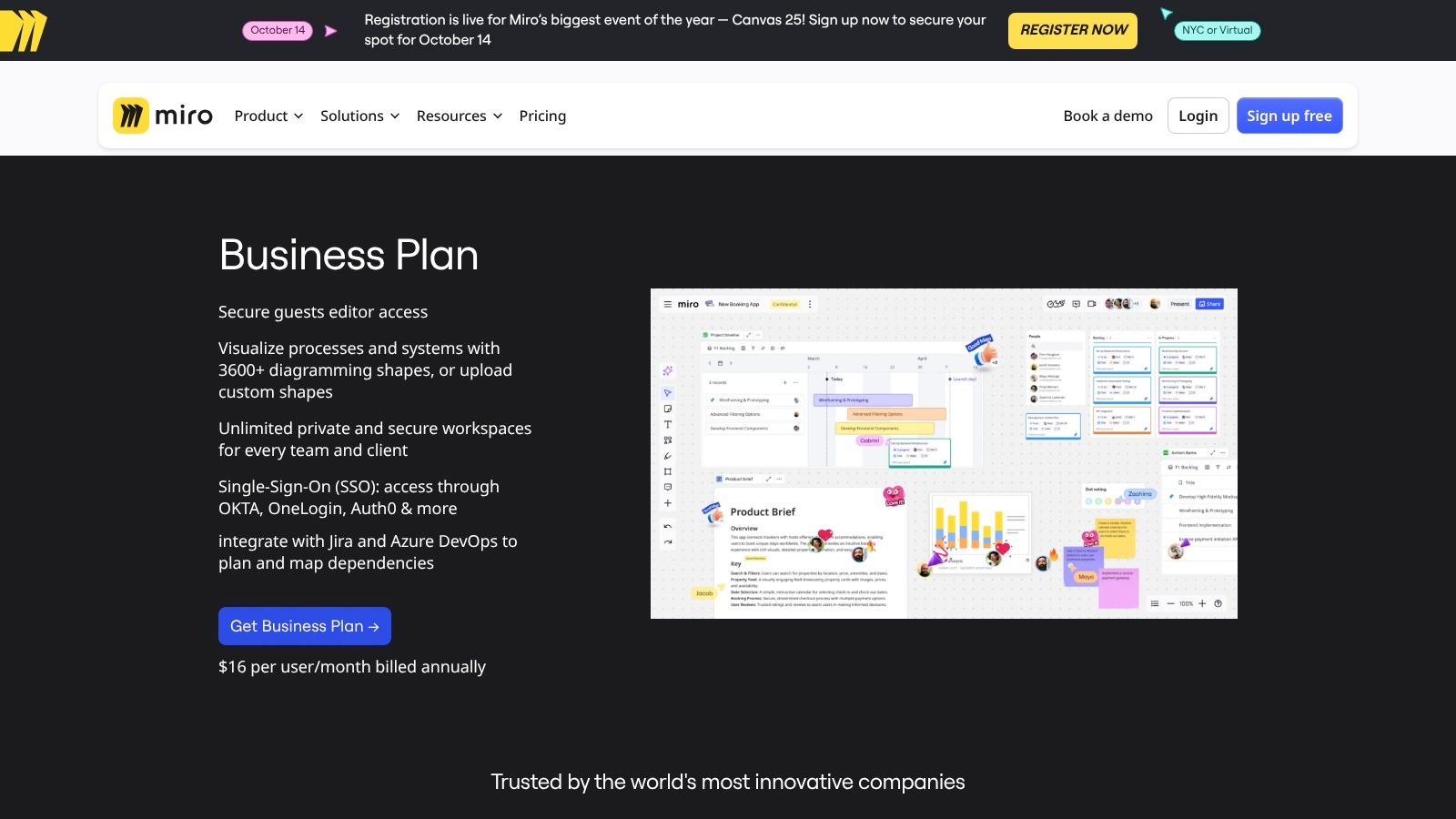
Miro's strength lies in its vast library of over 5,000 templates, covering everything from agile workflows to mind maps and organisational charts. This allows teams, such as engineering or construction project planners, to quickly structure their ideas without starting from scratch. With extensive integrations, it can pull in data and cards from other project management tools, creating a unified visual workspace that complements text-based platforms like Slack or Microsoft Teams.
Key Considerations
- Best For: Teams that rely heavily on visual collaboration, such as product development, marketing, and strategic planning. It is ideal for facilitating remote workshops, design sprints, and mapping complex systems.
- Limitations: The sheer number of features can present a steep learning curve for new users, potentially feeling overwhelming initially. Its per-user pricing model can become expensive for large organisations or when scaling up quickly.
- Pricing: Business plans, which include SSO and advanced diagramming, require contacting their sales team for a quote. Enterprise plans add features like data residency options. View plan details on the Miro Business Plan page.
9. Mattermost
For organisations where data sovereignty and security are non-negotiable, Mattermost offers a powerful, open-source alternative to mainstream communication platforms. It provides robust, real-time messaging capabilities similar to Slack, including channels, threaded discussions, and one-on-one audio calls, but with a critical difference: control. Because it can be self-hosted on a private cloud or on-premise servers, it ensures all communications and data remain entirely within an organisation’s own infrastructure. This makes it an exceptional choice for entities in NZ handling sensitive information, such as government agencies, legal firms, or large enterprises with strict compliance and privacy mandates.
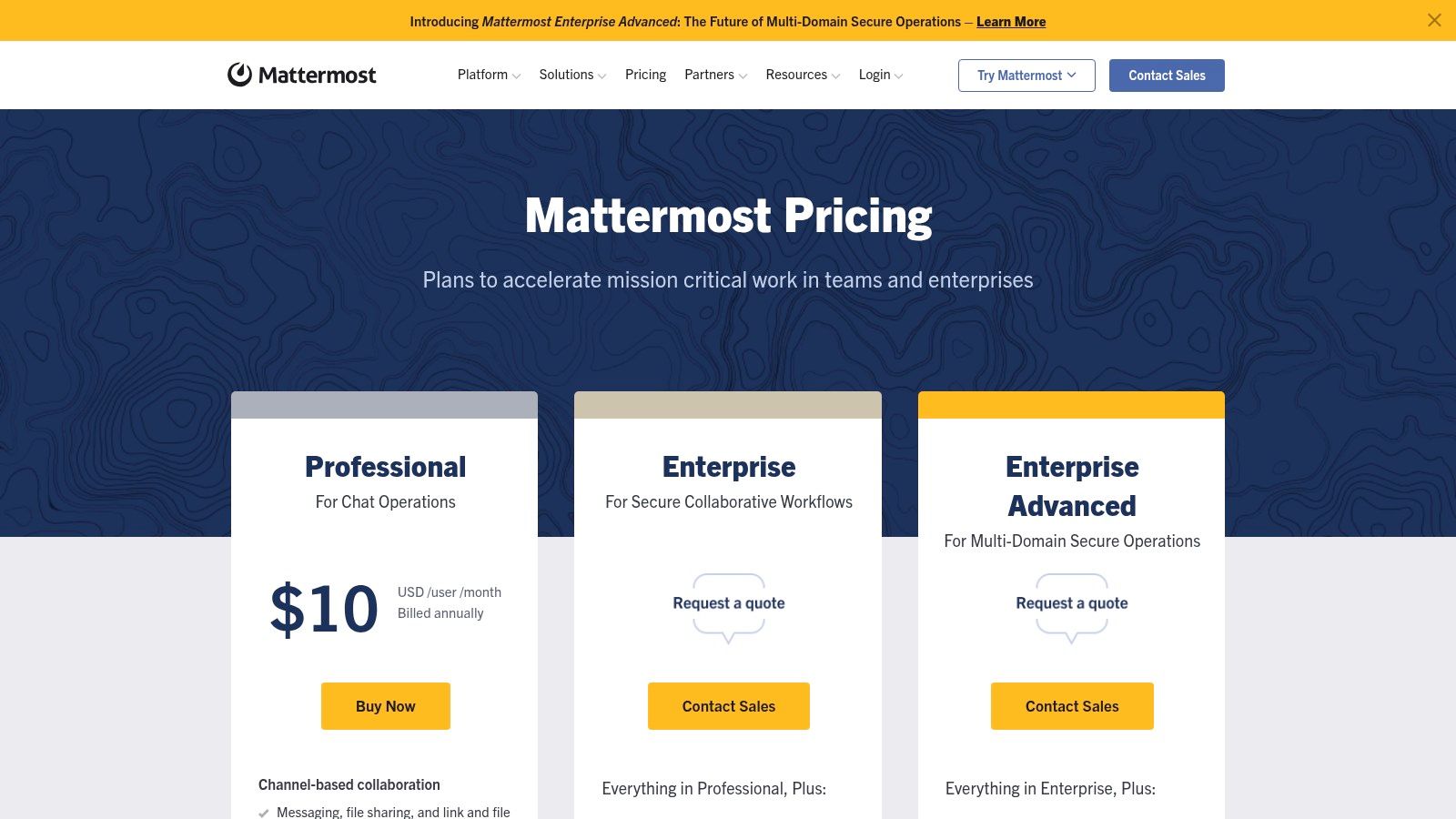
This level of control makes it one of the best communication tools for remote teams operating in highly regulated or security-conscious sectors. DevOps and technical teams particularly favour Mattermost for its deep extensibility and integration with developer toolchains. It can be customised to fit specific workflows, offering a secure environment for technical collaboration without exposing proprietary code or information to third-party services. The ability to operate in air-gapped environments is a unique advantage for critical infrastructure or defence-related projects where external network connections are prohibited.
Key Considerations
- Best For: Security-conscious organisations, government bodies, and DevOps teams needing complete data control, high security, and extensive customisation. It is ideal for industries where compliance and data privacy are paramount.
- Limitations: The primary drawback is the significant operational overhead and technical expertise required for self-hosting and maintenance. Compared to SaaS solutions, setup is more complex, and ongoing management demands dedicated IT resources, making it less suitable for smaller businesses without that capacity.
- Pricing: A free "Starter" cloud plan is available for small teams. Paid plans (Professional, Enterprise) offer advanced features like guest access, compliance exports, and enterprise-grade scalability. See current Mattermost pricing.
10. Workvivo by Zoom
Moving beyond daily project chatter, Workvivo by Zoom functions as a comprehensive employee experience platform, making it one of the best communication tools for remote teams looking to foster company-wide culture and engagement. It excels at unifying large, distributed workforces, such as those in nationwide logistics or multi-site manufacturing, by creating a central digital hub for company news, leadership updates, and employee recognition. This structure helps bridge the gap between head office and frontline staff, ensuring everyone feels connected to the organisation's mission.
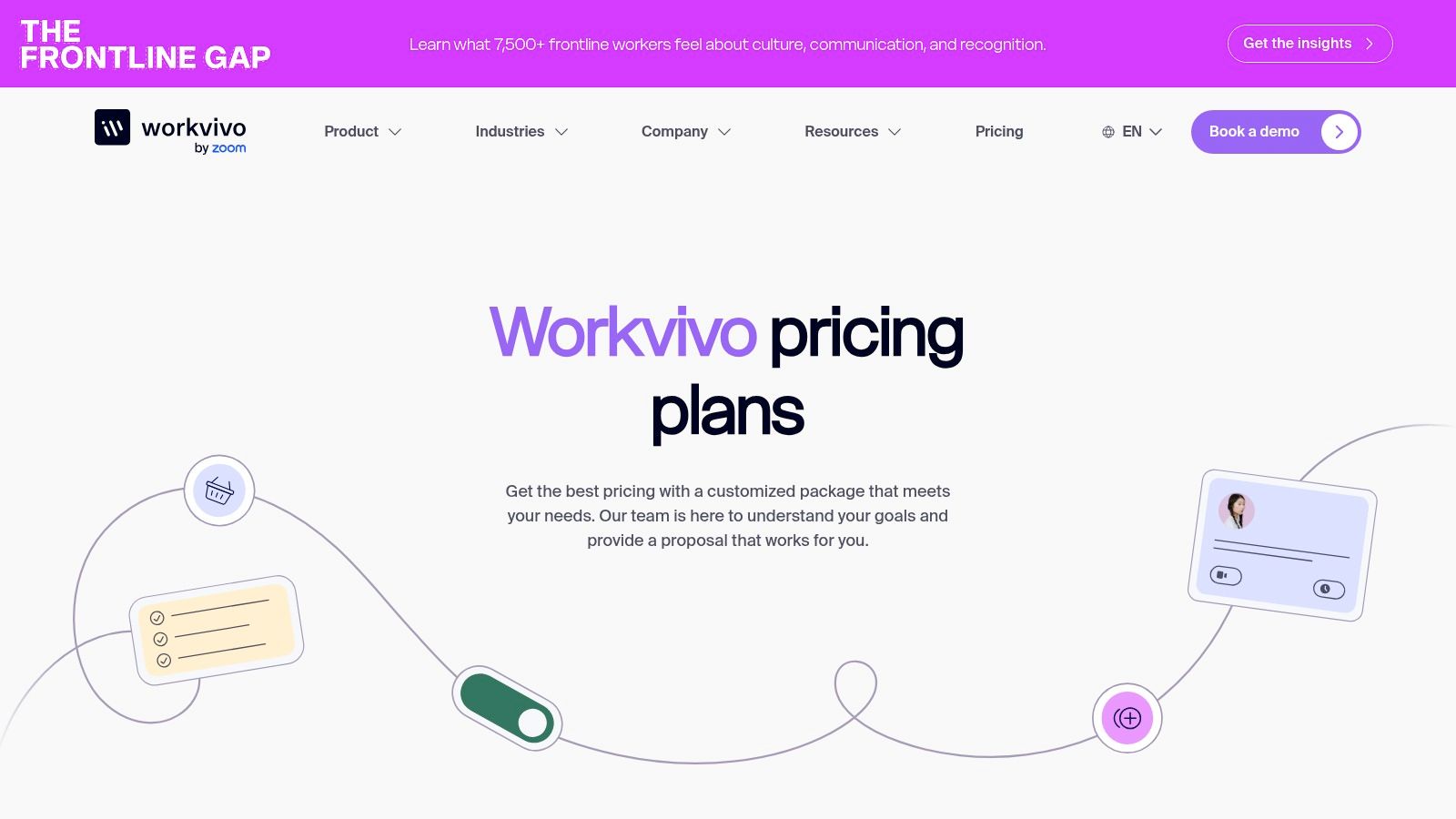
Its core features are designed for top-down and cross-organisational communication, including a central activity feed, article publishing, and live video streaming capabilities directly from leadership. For a large New Zealand-based agricultural firm with staff across multiple regions, Workvivo can be used to broadcast a CEO’s quarterly update, celebrate team successes with digital shout-outs, and conduct company-wide pulse surveys to gauge morale. The platform's emphasis on analytics provides valuable insights into employee engagement levels across different departments or locations.
Key Considerations
- Best For: Larger organisations (typically 250+ employees) in sectors like retail, hospitality, or transport, needing to centralise internal communications and build a strong, cohesive company culture across geographically dispersed teams.
- Limitations: The platform is primarily designed for larger enterprises, and its pricing structure and minimum spend can be prohibitive for small businesses or startups. Its focus is on broad, company-wide engagement rather than the granular, project-specific task management found in tools like Slack or Microsoft Teams.
- Pricing: Workvivo offers tiered plans (Business, Enterprise) with pricing provided upon request. Add-ons like Workvivo TV (for digital signage) and Advanced Analytics are available for an additional cost. See current Workvivo pricing.
11. G2 - Team/Employee Communication Software Category
When the sheer number of communication platforms becomes overwhelming, a resource like G2’s software category provides a crucial starting point. Instead of being a single tool, G2 is a comprehensive directory that aggregates user reviews and data on hundreds of team communication solutions. This makes it an invaluable research hub for organisations in New Zealand looking to compare the best communication tools for remote teams before committing to a specific platform. For a logistics company, this means being able to filter potential tools by features like fleet management integration or offline capabilities, then reading peer reviews from similar businesses.
The platform’s strength lies in its recency-weighted user ratings and comparison grids, which offer a quick, visual way to see how different software stacks up. You can quickly assess user sentiment, deployment options, and typical business size, helping you shortlist vendors that align with your operational scale, whether you are a small construction firm or a large-scale agricultural enterprise. It effectively streamlines the initial discovery phase of finding the right digital communication tool.
Key Considerations
- Best For: Businesses in the research and procurement phase, looking for a broad market overview, user feedback, and a structured way to compare dozens of software communication tools.
- Limitations: Information can sometimes be influenced by sponsored placements, and feature or pricing details are not always up-to-the-minute. It is essential to verify all information directly on the vendor's official website before making a final decision.
- Pricing: The platform is free to use for research and comparison. See G2's Employee Communications category.
12. PB Tech (NZ)
While software forms the core of digital communication, the hardware that powers it is equally critical for a seamless experience. PB Tech, as New Zealand's largest IT retailer, is the go-to source for procuring certified video conferencing equipment to complement platforms like Teams or Zoom. They provide the physical tools necessary to transform any space, from a home office to a corporate boardroom or a temporary site office, into a professional collaboration hub. This makes them one of the best communication tools for remote teams from a hardware perspective.
Their extensive range includes everything from high-definition webcams and noise-cancelling speakerphones to complete room systems from leading vendors like Logitech, Jabra, and Yealink. For industries like construction or logistics setting up hybrid meeting rooms, PB Tech offers business services for design, deployment, and ongoing support. This local expertise ensures Kiwi businesses can build reliable communication setups without navigating international shipping and support complexities. For teams operating in rural areas where such hardware relies on a stable connection, exploring the best rural internet options in New Zealand is a crucial first step.
Key Considerations
- Best For: New Zealand businesses needing to source and outfit remote and hybrid meeting spaces with certified, high-quality audio-visual hardware. It is ideal for IT managers and operations coordinators.
- Limitations: PB Tech is a hardware-only retailer; you must procure your communication software (like Zoom or Microsoft Teams) separately. Their focus is on equipment, not bundled software solutions.
- Pricing: Prices are listed in NZD and are GST-inclusive, ranging from affordable personal webcams to high-end, multi-thousand-dollar boardroom systems. View their current range at the PB Tech Video Conferencing section.
Top 12 Remote Team Communication Tools Comparison
| Solution | Core Features & Integration ✨ | User Experience ★★★★☆ | Value Proposition 💰 | Target Audience 👥 | Unique Selling Points 🏆 | Price Points 💰 |
|---|---|---|---|---|---|---|
| Slack | Channels, threads, 2600+ apps, audio/video huddles | Intuitive, broad ecosystem | Flexible, but scaling can be costly | Distributed teams, tech-savvy users | Large app marketplace, Slack Connect | Free & paid tiers; costly at scale |
| Microsoft Teams | Chat, meetings, telephony, deep MS 365 integration | Integrated with Microsoft apps, complex | Bundled with MS 365 reduces cost | Enterprises in Microsoft ecosystem | Enterprise security, compliance | Included with MS 365, add-ons extra |
| Zoom Workplace | Video meetings, chat, whiteboard, AI companion | Reliable, easy for guests | Strong external meetings | Teams needing external calls | Low friction for guests, AI-enhanced meetings | Multiple tiers plus add-ons |
| Google Workspace | Gmail, Meet, Docs, Gemini AI, co-editing | Simple onboarding, real-time collaboration | Transparent NZ pricing, easy use | Remote teams, Google ecosystem | Gemini AI integration, localized pricing | NZD pricing with 14-day trial |
| Cisco Webex Suite | Meetings, calling, AI noise removal, polls | Secure, enterprise-grade | Comprehensive unified comms | Regulated industries, large orgs | FedRAMP compliance, integrated PSTN calling | Region/reseller based pricing |
| RingCentral | Cloud PBX, video, messaging, 330+ integrations | Full business phone system replacement | Volume discounts available | Businesses needing full telephony | Strong telephony, global number support | Tiered, complex pricing |
| Loom | Async video messaging, AI summaries, screen recording | Reduces meetings, easy sharing | Great for async comms | Distributed, remote teams | AI-generated recaps, simple video sharing | Free & paid plans with trials |
| Miro | Infinite canvas, 5000+ templates, 160+ integrations | Visual collaboration focus | Scales well for workshops | Creative & planning teams | Strong visual & admin controls | Per-user pricing, steep at scale |
| Mattermost | Open-source messaging, self-hosted/cloud | High control, requires management | Full data control | Security-conscious, DevOps | Self-hosted option, enterprise governance | Subscription tiers vary |
| Workvivo by Zoom | Company-wide feed, live streams, analytics | Engages large, distributed teams | Designed for enterprise comms | Large orgs 250+ employees | Top-down and cross-org communications | Premium, high minimum spend |
| G2 - Software Directory | Feature filters, user ratings, vendor links | Insightful market overview | Free resource for comparison | Buyers & shortlisters | Extensive peer reviews, updated regularly | Free |
| PB Tech (NZ) | Certified video conferencing hardware | Local stock, fast shipping | One-stop hardware source | NZ businesses outfitting meeting rooms | NZ pricing with GST, local support | Hardware only |
Building Your Integrated Communication Strategy for NZ Conditions
Navigating the landscape of communication technology can feel complex, but as we've explored, the goal isn't to find a single, magical tool that solves every problem. Instead, building a robust communication framework is about creating an integrated ecosystem. The best communication tools for remote teams in New Zealand are rarely a one-size-fits-all software subscription; they are a carefully selected blend of digital platforms and rugged hardware tailored to the unique demands of our industries and geography.
For your office-based teams, project managers, and administrative staff, a central digital hub is non-negotiable. Platforms like Microsoft Teams or Slack provide the essential infrastructure for daily collaboration, file sharing, and project tracking. They are the digital equivalent of the central office, keeping everyone aligned regardless of their physical location. However, for a significant portion of the New Zealand workforce, the "office" is a construction site in Canterbury, a fishing vessel off the coast of Gisborne, or a remote forestry block in the central North Island. This is where the digital-only approach falls short.
Bridging the Digital and Physical Divide
The key takeaway from our deep dive is the critical importance of a hybrid strategy. Your digital hub must seamlessly connect with your field operations. This means pairing the power of Zoom or Google Workspace with the undeniable reliability of purpose-built hardware.
Think of it as a layered approach:
- The Digital Layer: Your chosen software (Teams, Slack, etc.) acts as the brain of your operation, handling asynchronous messaging, video calls, and document management.
- The Connectivity Layer: This is the bridge. For teams in urban or well-covered rural areas, 4G/5G networks are sufficient. But for those working beyond the reach of cell towers, solutions like Iridium satellite phones or Starlink for Business become indispensable utilities, not luxuries.
- The Field Layer: This is where safety and operational continuity are paramount. Push-to-talk (PTT) over Cellular devices, digital mobile radios (DMR) from brands like Tait, and satellite messengers provide instant, reliable, one-to-many communication that is essential for coordinating crews, managing logistics, and ensuring worker safety in line with Health and Safety at Work Act obligations.
Actionable Steps for Implementation
Choosing the right tools requires a strategic, not a reactive, approach. Before committing to a solution, your organisation should undertake a thorough needs analysis.
- Map Your Operations: Where do your teams actually work? Chart out every location, from the main office to the most remote worksite. Assess the available cellular and internet coverage in each zone.
- Define Communication Needs: What kind of communication is most critical? Is it instant voice for safety coordination (radio), data-heavy project updates (team chat), high-quality video for client meetings (video conferencing), or lone worker safety alerts (satellite messenger)?
- Audit Your Existing Toolkit: What are you using now? Identify what works, what doesn't, and where the critical communication gaps are. This prevents you from paying for redundant features.
- Consider a Phased Rollout: You don't need to implement everything at once. Start by addressing the most critical gaps, such as implementing reliable communication for your most remote or high-risk teams.
- Prioritise Training and Support: The most advanced tool is useless if your team doesn't know how to use it properly. Factor in comprehensive training, especially for safety-critical hardware, to ensure user adoption and correct usage in an emergency.
Ultimately, crafting the perfect communication strategy is a journey of continuous improvement. By thinking in terms of an integrated ecosystem rather than a single app, you can empower your teams, enhance productivity, and build a safer, more connected operation across the diverse and challenging landscapes of Aotearoa.
Ready to bridge the gap between your office and your field teams? The experts at Mobile Systems Limited specialise in providing, installing, and supporting the rugged hardware solutions that power New Zealand's leading industries. From digital radios and satellite phones to custom vehicle installations, we can help you build the reliable communication foundation your business needs to thrive. Visit Mobile Systems Limited to explore hire options and get tailored advice for your specific operational challenges.


